Modern Art & Design presents several important works by Sigrid Hjertén
"Blondinen på terrassen"
When the Hjertén-Grünewald family returned to Paris in 1920 after nearly a decade in Sweden, they were accompanied by Isaac’s sister Bertha, who changed her name to Berthe upon arriving in France. They were in search of housing and a studio in Paris, but prices had gone up since their last stay in the city when they were students of Matisse. They ventured outside the bustling city blocks and settled in Fontenay-aux-Roses, southwest of Paris. It was a peaceful and blossoming suburb where the family resided in a house with a garden. Berthe helped with their son Iván, allowing Sigrid better opportunities to paint. Their stay in France in the 1920s marked a broadening of Sigrid’s art, She didn’t paint as much as before but developed an intimate color expressionism that was no longer under the influence of her old teacher Matisse, but rather under the influence of van Gogh.
In more or less anonymous depictions, the woman often constitutes a central theme during this period. The female figures can be interpreted as the various roles that Hjertén identified with-woman, avant-garde artist, wife, mother and intellectual. In her painting, she explores the expressions of these different personas. Over the years, she paints several portraits of women including “Brunetten och blondinen” (1912) Den röda rullgardinen” (1916), ”Dekorativt huvud (Det gröna ansiktet)” (1918), ”Berthe i röd hatt” (1921) and the painting in the auction ”Blondinen på terrassen” (1923). She is not alone in depicting the female body within avant-garde circles, but unlike many of her male colleagues, she takes a step away from portraying the female body in the conventional sense and instead seeks something else. This quest resulted in fantastic paintings with vibrant colors and skilfully executed brushstrokes.
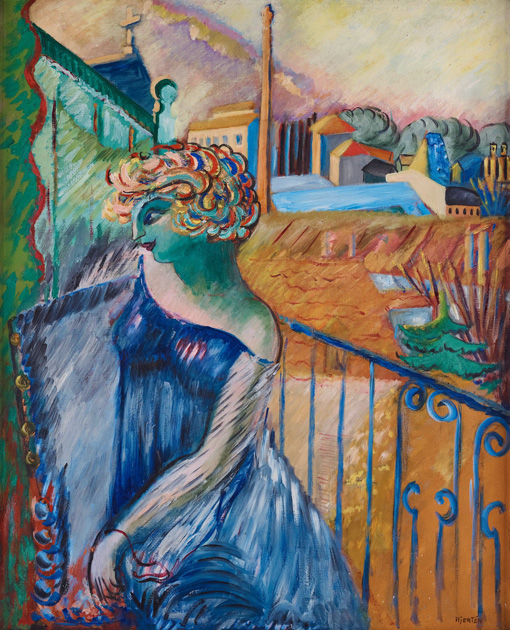
Several of the early 1920s paintings have a truly masterful color composition. Sigrid paints with a newfound strength, a bold brushwork, quick and intense. Contracts create the atmosphere in “Blondinen på terrassen ” Foreground and background interchange, and the blonde’s head stands out with the same clarity as the city in the background. Sigrid builds the painting’s color scheme with a variety of values, contrasting cool colors with warm ones. Colors meet in intense contrasts, and the contours dissolve into the colors with warm ones. Like van Gogh, she made the subject quiver, vibrate and sway. The path to this resonant colorism went from Sigrid’s background in drawing, through her time as a student with Matisse in the 1910s, encounters with Cézanne and cubism, to her own intimate color expressionism. In Görel Cavalli-Björkman’s book, she writes that the subject was executed in the Paris studio, and the model in the picture is likely Bronia Perlmutter, who was also depicted by Isaac Grünewald and Nils Dardel.
In 1932, the Hjertén-Grünewald family moved back to Sweden, and Sigrid developed the mental illness that would come to affect the remaining years of her life. Today, we regard Sigrid Hjertén as one of the most beloved modernist of the 20th century. However, during her lifetime, she only managed to hold one solo exhibition at the Royal Academy of Fine Arts in 1936. By that time, she was already seriously ill and institutionalized in a mental hospital, and she did not get to fully experience the exhibition. Her fellow artist colleague Tor Bjurström wrote 1949 for Paletten, “ As she is, Sigrid Hjertén is one of the foremost female painters our country has ever had, and the first great one.”
To be sold at Modern Art + Design
Estimate 3 000 000 - 3 500 000 SEK
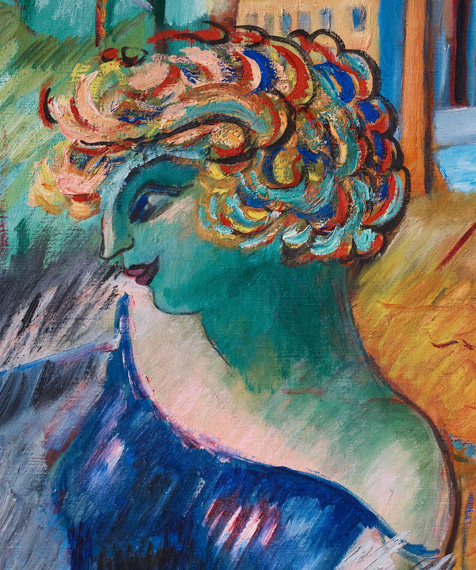
”Södra landet”
In the autumn of 1911, Sigrid Hjertén and Isaac Grünewald managed to rent a small loft at Kornhamnstorg in Gamla Stan, Stockholm. They were young, poor and had just returned from Paris, where they had both studied with Henri Matisse at the Academie Matisse. In November, their son Iván is born and Isaac and Sigrid get married. It is important for Sigrid to continue painting, and childcare is then arranged by Isaac's sisters Dora and Bertha, who take care of their young son as well as modelling for the artist couple.
From her combined apartment and studio on Kornhamnstorg, Sigrid Hjertén looked out over beautiful Stockholm. The view was breathtaking - to the south, she faced the heights of Slussen and the busy loading dock below, which was visited daily by merchant ships, workers and strollers on the pier. Below the window, the sound of the crowds between the market stalls could be heard from early morning to late evening. In 'Södra landet', 1912, she excels with outstanding technical skill and a boldness of colour that is completely analogue to modern painting in Sweden. The composition consists of water and a sailboat in the foreground, beyond which the walls glow an intense yellow colour and the houses and warehouses of Södermalm, or Söderlandet as it was then called, loom large. During this period Hjertén painted several paintings with perspectives and city views from Kornhamnstorg, such as "Från Kornhamnstorg", 1912 (Malmö Museum), "Torget", 1913 (Stockholm City Administration), "Den blå skutan", 1912 and the current painting "Södra landet”.The painting was exhibited at the momentous 'Expressionistutställningen' at Liljevalchs Konsthall in May 1918 and has subsequently been included in numerous exhibitions.
Sigrid Hjertén was a pioneer of her time. Her courage and determination took her from Sundsvall to Stockholm and on to the great art metropolis of the 20th century, Paris, where she arrived in September 1909. Many young artists travelled to Paris in the early 1900s and the word of the city's new radical painting had quickly spread to Scandinavia. Henri Matisse, who was a well-known artist in the city after his breakthrough at the 1905 Salon d'Automne, opened his Académie. The education at the Académie was free and therefore many young foreign artists living in Montparnasse, including Sigrid joined the school along with other Swedes. Matisse immediately noticed the young Swede's talent and Einar Nerman has described a particular episode: "I remember so well when one day Sigrid Hjertén's study was to be criticised. It was only a few dabs of colour that she had nonchalantly placed on the stretched canvas. A few mild colour chords, reminiscent of the old Swedish peasant fabrics that she had so recently studied and copied at the Nordiska museet in Stockholm. It was something new in colour and tone, and when the master stopped in front of her canvas, there were exclamations of delight: 'C'est merveilleux! C'est ravisant!' A rush of admiration goes through the evoutly listening crowd. Matisse has discovered her."
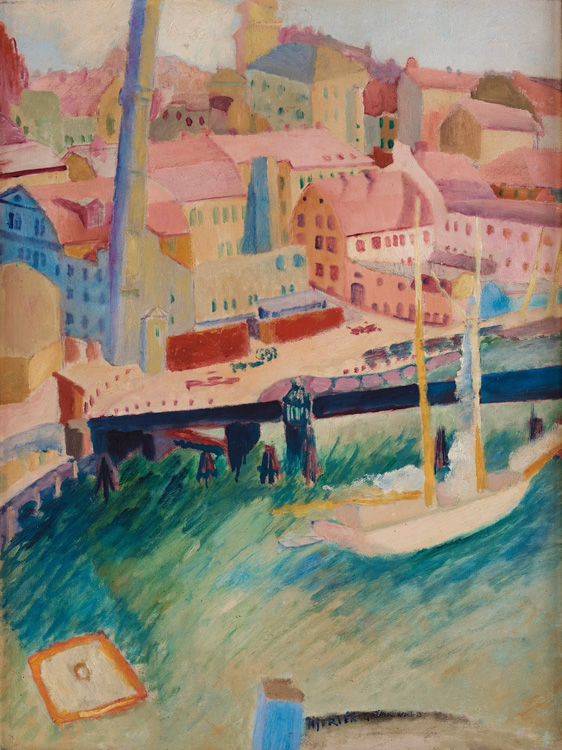
Sigrid was a true expressionist, influenced by both Matisse and Cézanne. By 1912, Sigrid Hjertén had blossomed as an independent artist who dared to go further than her contemporary colleagues in art. In 'Södra Landet', her sense of colour is particularly dominant, as she combines shimmering turquoise blue with soft pink and yellow tones with a unique sense of colour.
To be sold at Modern Art + Design
Estimate 3 000 000 - 3 500 000 SEK
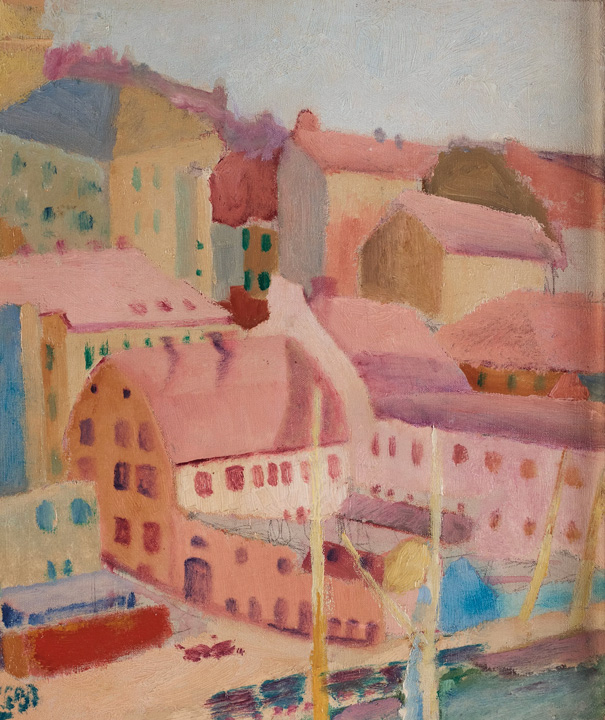
"Harlekin"
Görel Cavalli-Björkman writes about Sigrid's painting in the 1920s and about Harlekin: "The paintings become more intimate and provide a deeper interpretation of reality. The importance of colour is still highlighted in the painting Harlekin, a still life where Sigrid has draped a romb-patterned curtain over the back of a chair and placed a doll representing Isaac leaning against an antique female torso. The Isaac doll, as well as a companion doll depicting Sigrid, were already in the artist's home. These dolls were made by fellow artist Marie Vasilieff. The art world Sigrid had encountered on her return to Paris was quite different from that of her school years. There was now a general desire to break away from pre-war expressionism and return to figurative art. The literary subjects of academic painting had been completely abandoned by the avant-garde. During the interwar period, the Italian commedia dell'arte was rediscovered. It became a kind of alternative, a modern mythology with its different types of picturesque characters and masks. Picasso, more than any other artist, came to devote himself to this circle of motifs. He had studied Neapolitan Street theatre and used its characters in his costumes and set design for Jean Cocteau's production of Parade for the Russian Ballet. The Harlequin figure became his alter ego throughout his life, dominating his sketchbooks from 1915-16.
Sigrid's choice of the Harlequin motif in the painting “Harlekin” shows that she was aware of the importance of Commedia dell'arte at the time. She connects to it with the Isaac doll and the chequered drapery, which she jokingly refers to as the 'Kipasso dress'. Its romb-pattern in blue and red is traditionally found in the Harlequin's costume. As well as the painting “Harleking” makes a general reference to Picasso, Sigrid takes the opportunity to tease her own Harlequin, who constantly seeks comfort at the breast of Venus. She had previously painted the pair of Harlequin and Columbine, perhaps as a portrait pair alluding to herself and Isaac" (Prins Eugens Waldemarsudde, Stockholm, "Sigrid Hjertén - En mästerlig kolorist", page 25).
To be sold at Modern Art + Design
Estimate 2 000 000 - 3 000 000 SEK
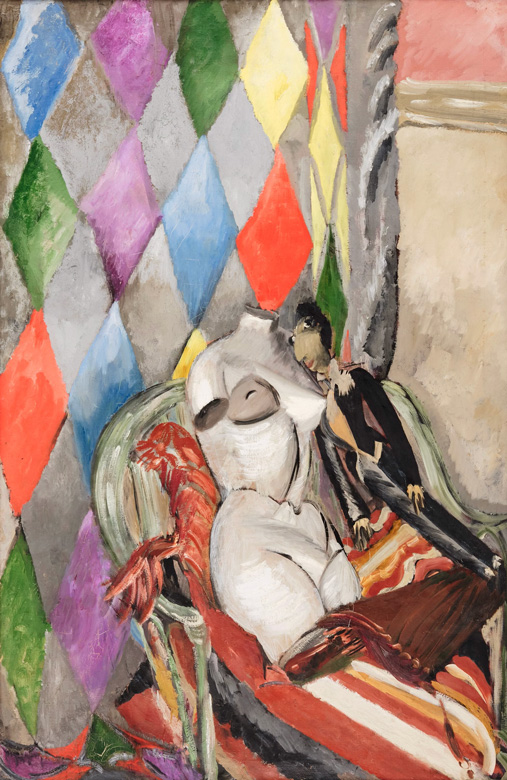
> Sigrid Hjertén and Isaac Grünewald in the studio with the doll representing Isaac by Marie Vassilieff.
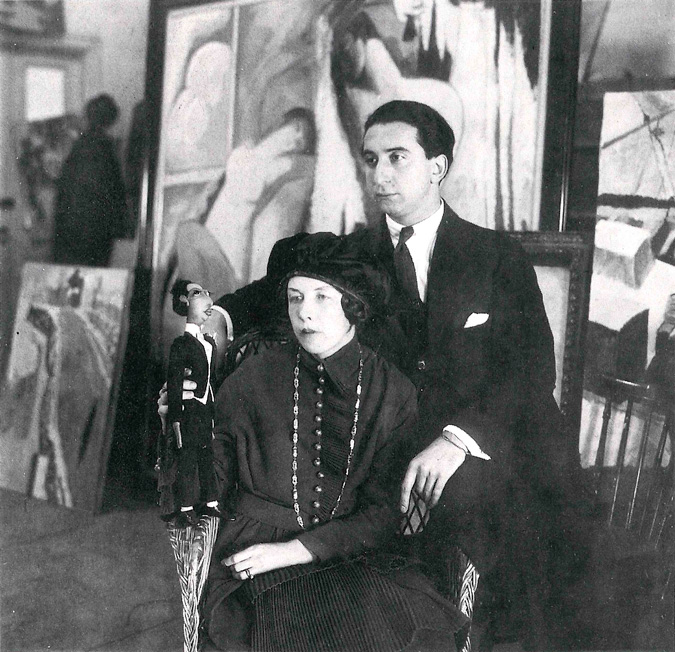
A tapestry
Sigrid Hjertén was born in Sundsvall in 1885, the daughter of Svante and Maria Hjertén. When Sigrid was two and a half years old, her mother passed away. Her father, who was a lawyer, later remarried Tora Östberg, and the family moved to Stockholm in 1897. Tora Östberg was the sister of the architect Ragnar Östberg, who, among other things, designed Stockholm City Hall. Ragnar Östberg developed a close relationship with Sigrid, and when she was accepted as a student at the Higher School of Arts, Crafts and Design, with textiles as her main subject, Sigrid occasionally assisted Östberg's architectural office with orders. In her book "Woman in the Avant-Garde," Cavalli-Björkman writes the following about this tapestry: 'In the archives at Kulturen in Lund, there is information that mr Ahlmark, who collaborated with Ragnar Östberg at the design of the City Hall in Stockholm, owned a furniture piece designed by Östberg with marquetry by Sigrid Hjertén. The archive also contains a picture of a tapestry with plant motifs owned by Ahlmark, designed by Sigrid and woven in 1907.' The archives in Lund also state that the tapestry was sold at an auction in Stockholm in 1978.
To be sold at Modern Art + Design
Estimate 250 000 - 300 000 SEK

Modern Art + Design
Viewing: November 9–14, Berzelii Park 1, Stockholm
Open: weekdays 11 am–6 pm, weekends 11 am–4 pm
Auction Live: November 15–16, Arsenalsgatan 2, Stockholm

Work by Sigrid Hjertén at Modern Art + Design

Hammer price
250 000 SEK
Estimate
250 000 - 300 000 SEK

Hammer price
90 000 SEK
Estimate
40 000 - 50 000 SEK

Hammer price
2 500 000 SEK
Estimate
3 000 000 - 3 500 000 SEK

Hammer price
160 000 SEK
Estimate
175 000 - 200 000 SEK

































